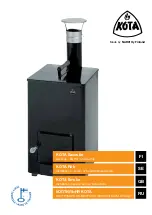
The gain is adjusted by potentiometer R306 in the
feedback circuit of operational amplifier number
one. After this amplification the signals are Split to
bass circuits & midrange/tweeter circuits.
5 Bass Circuits
The signal passes the bass control circuits R311,
Z301 (12,13,14), which controls the signal level to
the woofers. The bass control circuits affect higher
frequencies (e.g. 100Hz) more than low frequencies
(e.g. 30Hz).
The bass signal then passes via a low-pass link
R313, C306 which forms one part of the crossover
filter between bass & midrange.
The next link is a high-pass filter, which cuts
frequencies below 30Hz 12dB/octave, & is part of
the woofer's total transfer function.
1.6 Ace-Bass* Circuit
The power amplifier for the woofer, together with
Z302 (1,2,3,5,6,7) forms the ACE-BASS*, amplifier,
which can be represented by the diagram below
R412 & Z302 (1,2,3) sense the voice coil current in-
the woofers. Z302 (5,6,7) acts as a band-pass filter &
sums signals from &
Ⓓ Ⓕ
The power amplifier for the woofer is inverting &
acts as adder for signals from & .
Ⓔ
Ⓕ
The part of the current signal which is fed back
Ⓕ
positively produces the negative output resistance R
S
.
The parallel resonant circuit Lp, Rp, Cp is formed
by negative feedback of the current signal via the
band-pass filter.
*ACE-BASS = Amplifier Controlled Euphonic Bass.
1.7 Midrange And Treble Circuits
From the gain control the signal is also fed to the
midrange/treble amplifier. Z301 (5,6,7) acts both as
high-pass filter for the crossover (C502, R501,
R502) & as treble boost filter (R505, R506, C503).
The high-pass link C504, R507, R508 forms the
second part of the crossover filter between bass &
midrange.
The power amplifier is of the inverting type, & acts
as, operational amplifier for the treble control R510,
which is active above 5kHz.
POWER AMPLIFIER CIRCUITS
1-8 Power Stage For Woofers
The signal is coupled via C703 to the input of the
power amplifier.
From the output, the signal is fed back negatively via
R 709 & C704. When the signal amplitudes are large,
negative feedback also is provided via a network of
resistors & diodes. The output signal is compared to
the supply voltage, & a couple of volts before
clipping will occur, the signal will be rounded by the
diode network so the clipping is soft.
The input stage consists of a differential stage V702
& V707 fed via a constant-current generator, V701.
The output stage is of Darlington design with
transistors V710-V711 & has AC gain -1. V707
senses the temperature of the output transistors so
that the bias current is constant.
V705 & V709 filter the supply voltage for the input
stage, eliminating hum & other kinds of noise. (If
A4-14 "pops" when switched on, one of these
transistors is probably shorted).
No-signal DC-levels of voltages & currents are
shown in the circuit diagram enclosed.
To avoid on & off-transients, the bass amplifier is
active only when the supply voltages 17V,
so that the operational amplifiers always work
properly when the bass amplifier is active, When
diode D712 starts conducting, the constant current
generator V701 starts working, & via V712 activates
even current generator V706. The amplifier is
inactive when these current generators are shut off.
1.9 Power Amplifier For Midrange And Tweeter
The power amplifier is similar to the bass amplifier
but the diode network for soft clipping is not
included. The voltage delayed on-function is also
eliminated, so this power amplifier is active at low
supply voltages.
The signal from the power amplifier is split in
passive crossover filters L602, C616, C617 to
midrange & C614, C615, L601 to the tweeter.
2 Of 3


























